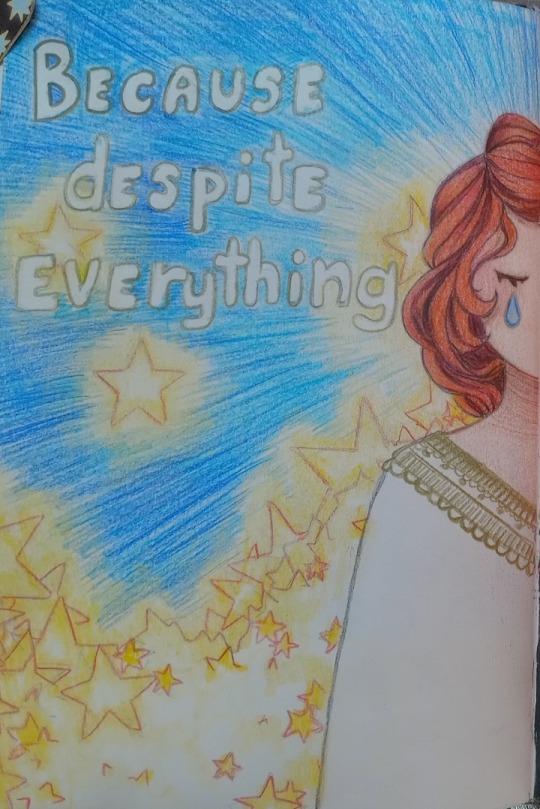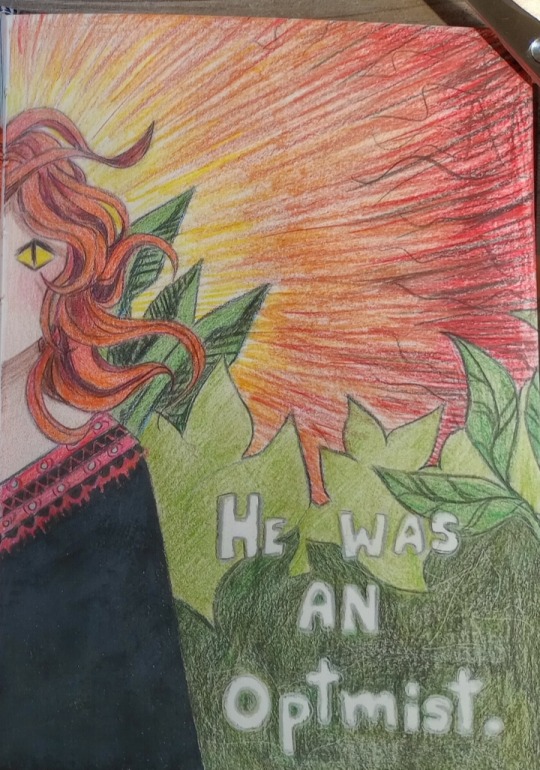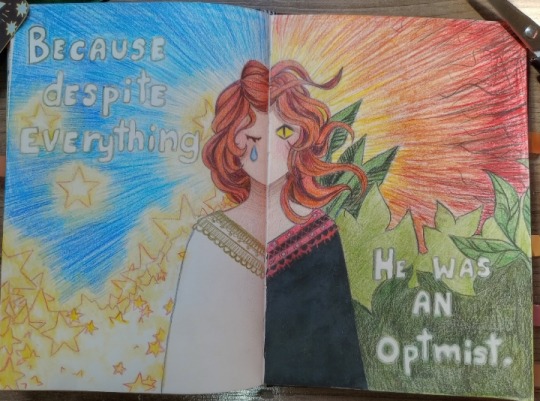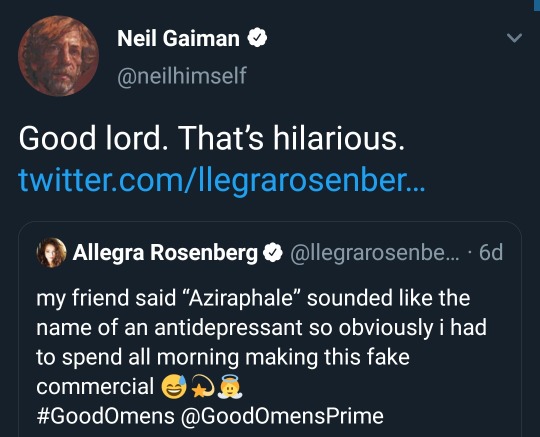Don't wanna be here? Send us removal request.
Text
What a lovely reading of this line!
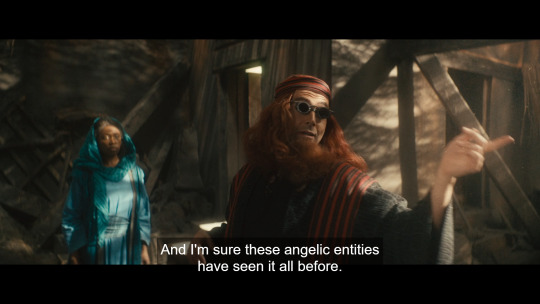
Crowley referring to Gabriel, Michael, and the others not as "angels" but as (the honestly more accurate) "angelic entities" in front of Aziraphale is such a wonderful bit of flirt.
Crowley very deliberately not using "angel" to describe anybody else as a nod to Aziraphale that Crowley's romantic pet name for him is a word that he sees as belonging just to Aziraphale is really sweet.
Romancing his angel and shading angelic entities have always been the twin passions of Bildad the Shuhite.
#good omens#crowley#aziraphale#ineffable husbands#good omens meta#Crowley knows what he's doing#no accident#ineffable flirting
5K notes
·
View notes
Text
Miranda from The Tempest and A Companion to Owls.
I remember some time ago a fan pointed out that this scene was incredibly reminiscent of “Miranda” by John William Waterhouse and added Aziraphale on the rock contrasted with the first painting (1875). However, another version of the same painting exists; featuring a red-hair Miranda, which was painted afterwards in 1916.
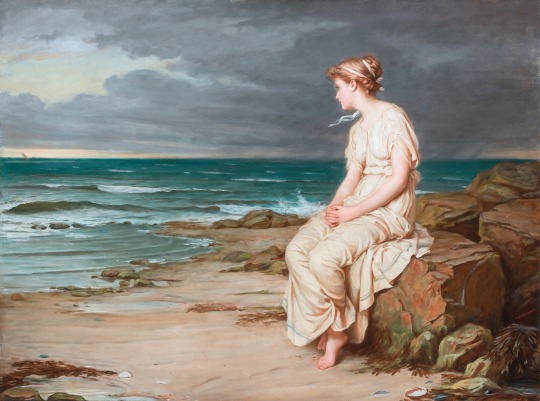
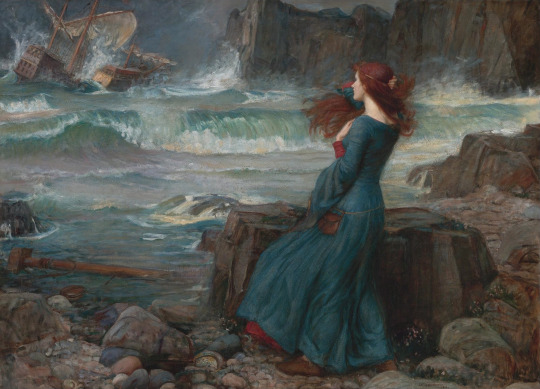

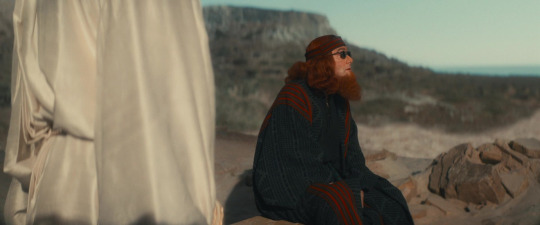
The Miranda here is a character from William Shakespeare's The Tempest. She was detained on an island, together with her father, Prospero, for almost twelve years. This happened as a result of having been exiled from Milan by Prospero's power-seeking brother, Antonio.
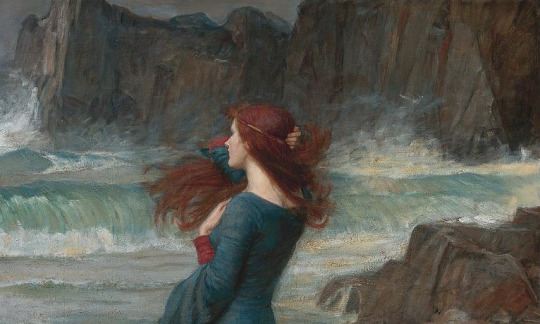
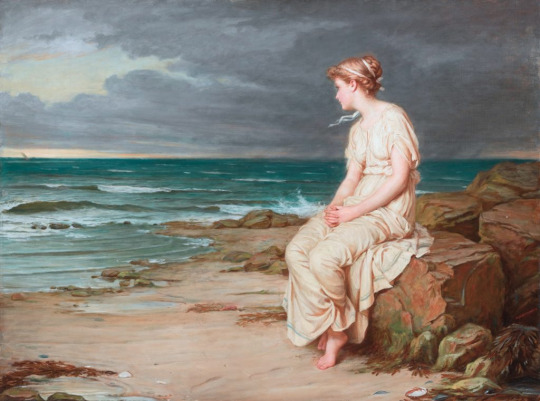
The scene plays very blatantly with the word “exile” and Aziraphale fearing being cast into Hell (exiled from Heaven) and Crowley’s clear banishment from his position as an angel.

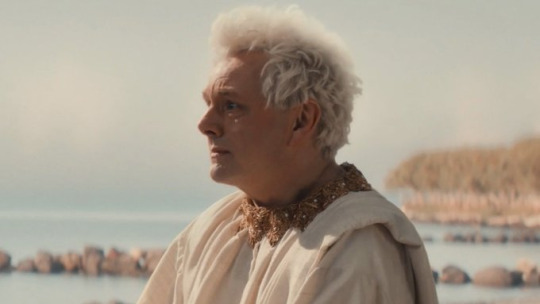
The picture has been painted in cold (red hair) and warm tones (blond), playing very much into the tones we get to see in A Companion to Owls. Aziraphale’s side on the rock, with the more conventional, peaceful look and Crowley’s with the rocks on the background.
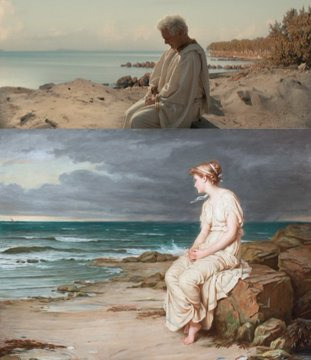
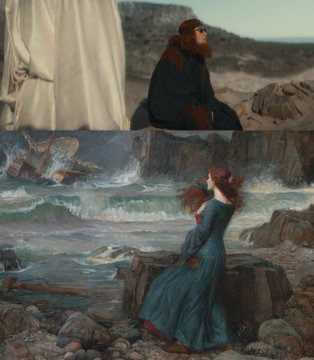
A ship slices through the waves, causing a feeling of imminent loss; notice how that is exactly Aziraphale’s placement on the frame.
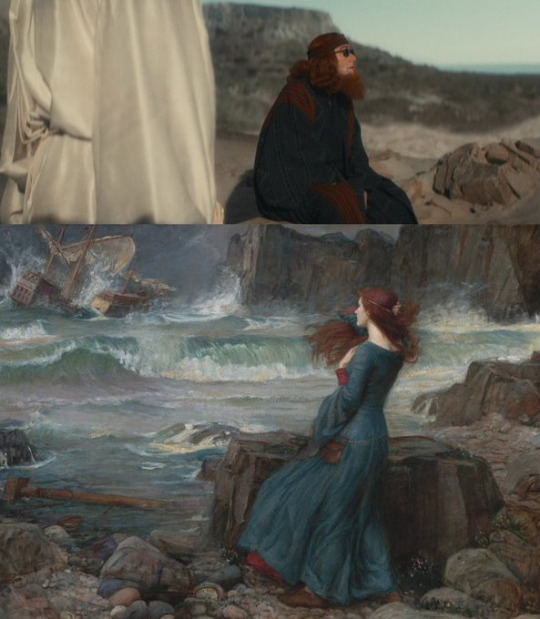
Unlike the paintings though, in Good Omens we get a view of both sides, of before and after the storm. The color palettes combine as both Aziraphale and Crowley are fitted into the frame.
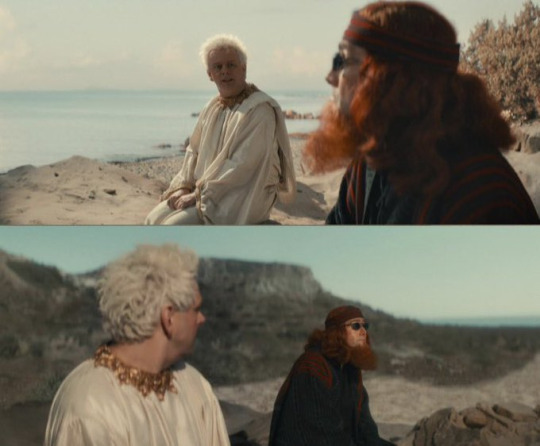
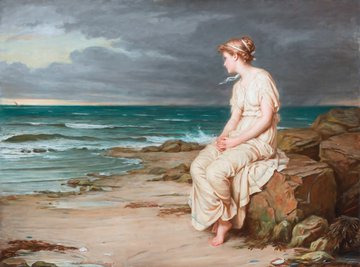
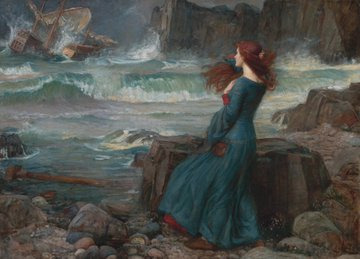
Concluding with the wonderful shot directly mirroring their color palettes (sunnier on Aziraphale’s side; shadows on Crowley’s) again and reversing the order of the Miranda paintings (not chronologically, as we see red-hair Miranda appear later on, but in terms of placement and coloring).
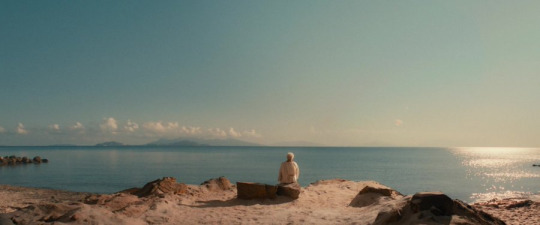
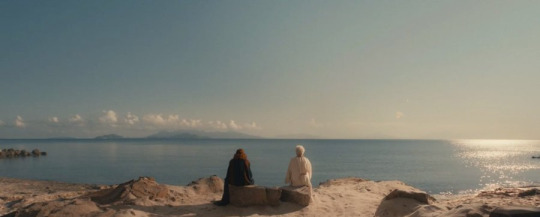
301 notes
·
View notes
Text
Something about David Tennant's red carpet BAFTA suit feels Tang suit-inspired to me: the long cut of the jacket, the beading around the wrists to suggest contrasting cuffs, the chain closure across the front to suggest a frog button closure. The red and gold beading is also suggestive of the Lunar New Year we just celebrated. And what year is it? The Year of the Snake!
(I know next to nothing about fashion or Chinese culture so please forgive any offense to either.)


#good omens#crowley#ineffable husbands#david tennant#gomens#good omens season 3#bafta awards#bafta 2025#bafta#red carpet#year of the snake#snake crowley#make some trouble
54 notes
·
View notes
Text
Georgia flat out trolling the fandom now
Georgia posted a black and white photo of David :D

#good omens#gos3#season 3#david tennant#aziraphale#crowley#ineffable husbands#gomens#where's the hair
860 notes
·
View notes
Text
Just looking at all the wonderful LCC pictures of Michael Sheen, noticing the beard, remembering they will soon start filming, and wondering if we will actually get bearded Aziraphale 🥹
#aziraphale#michael sheen#good omens season 3#good omens#bearded aziraphale#gomens#ineffable husbands
32 notes
·
View notes
Text

#good omens#crowley#aziraphale#ineffable husbands#aziraphale x crowley#good omens season three#good omens season 3#90 minutes#good omens fandom#amazon prime#we'll be okay
45 notes
·
View notes
Text
Good Omens Historical Trivia That's Haunting Me Today...
So we all know A.Z. Fell & Co is located on the fictitious Whickber Street in Soho and was established in 1800.

Aziraphale has run the shop ever since then and was in contact with Crowley at least until the 1820's when they took their little jaunt to Edinburgh and Crowley got sucked down the tube slide to Hell. They meet up again no later than the 1860's, when Crowley asks for Holy Water.
Stands to reason that between the 1820's and 1860's Aziraphale was in Soho doing Aziraphale things. Running his bookshop. Eating tiny cakes
Yeah... you know what else was going on in Soho during that time?
The worst cholera epidemic in London history.
If you don't know, cholera is a deadly bacterial infection caused by drinking contaminated water. Prior to the 1850's humans weren't really sure what caused cholera, but they knew it was terrifying and also that it was absolutely epidemic in big cities.
TW: this is gross - The main symptoms of cholera are agonizing stomach pain and non-stop watery diarrhea, eventually leading to the skin turning blue due to the thickening of blood from severe dehydration. Patients can lose more than 20% of their body weight in hours as they quite literally evacuate every drop of water in their bodies until they die of heart failure. - OK gross part over
Cholera symptoms show up as short as 5 hours after infection and could kill within as little as 12 hours. Cholera was especially terrifying because of how quickly and painfully it killed you, and because the patient maintained mental clarity up until the point of death. More than half of the people who contracted cholera died within a few days after consuming the bacteria-contaminated water.
And guess what water had cholera bacteria in it?
The public water pump on Broad Street in Soho in August of 1854
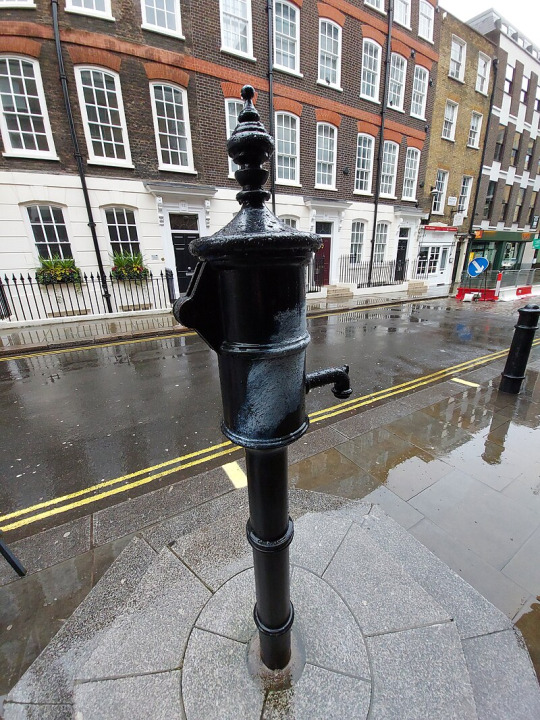
And this wasn't one of those epidemics that starts slowly and drags on. It hit like a bomb. It killed 600 Soho residents in ten days.
That's roughly 60 people a day in a 3-4 block area. Most of them died at home because the disease struck too quickly for them to to make it to a hospital. Survivors described hearses stacked with coffins 4-5 high going down the street nonstop all day long during the outbreak. Entire families were wiped out overnight.
What does that have to do with Good Omens?
Aziraphale's book shop was right in the epicenter of this outbreak.
Neil Gaiman has been pretty free about the fact that Whickber Street is a thinly veiled expy of the real Berwick Street in Soho.
This is a famous map showing the 1854 Soho Cholera epidemic. I highlighted Berwick Street and the public water pump that was the center of the contagion. The black bars (I circled a few in blue) on the map designate deaths. The thicker the black bar, the more people died in that particular house.
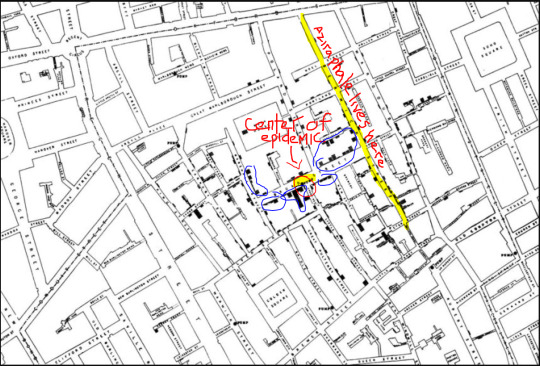
51 people died the week of the cholera outbreak on Aziraphale's Street alone.
Cholera was one of those diseases that provoked a lot of panic, not just because of how fast and painful it was, but because of the way it didn't follow common conventions about class or age. Children died while the elderly survived (often because the elderly had no one to gather water for them). Lower class houses were spared while their middle class landlords died. Churches were packed that week, because people in Soho had no idea who would get sick next. The epidemic pretty much burned itself out in a week and a half, since by that point everyone who drank the water had already died. I have to wonder what our resident Angel was up to during that time. Obviously cholera can't hurt him, but that's his neighborhood. There's no way hundreds of people, including entire families with children, are dying painfully in his neighborhood and Aziraphale doesn't notice. That means that in between this scene:
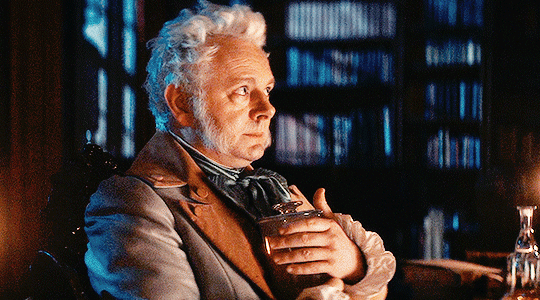
And this one:

Aziraphale would have watched one of the worst disease outbreaks in London history play out right outside his front door. I feel like there's great potential for a good story there if anyone better than me wants to write it.
538 notes
·
View notes
Text
Making an exception to my Good Omens only content because this is one of the funniest things I've ever seen
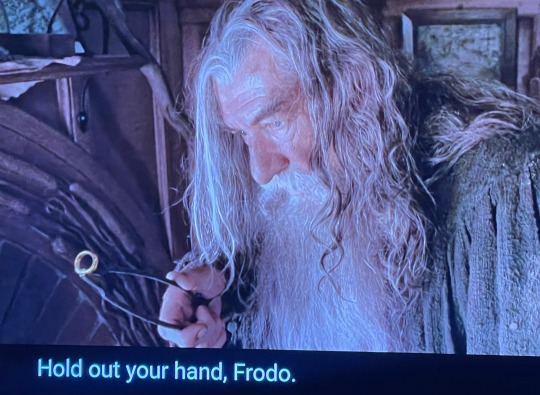
why didn’t gandalf just carry the ring to mordor himself with these tongs
157K notes
·
View notes
Note
What’s your favourite line from good omens?
The invisible and unbreakable one that joins Crowley and Aziraphale.
16K notes
·
View notes
Text
One of the funniest bits of the Bark Ruffalo BAFTA sketch to me was how David Tennant kept asking people in the audience if they were good with dogs and they all reached to take the dog and David had to actively pull away from them because c'mon - when David Tennant offers you a puppy YOU SAY YES.
#david tennant#bafta#bafta awards#bafta 2024#michael sheen#michael and david#ineffable husbands#ineffable spouses#bark ruffalo#baftas
918 notes
·
View notes
Video
"All married people"
youtube
Given the nature of the Internet, you may need this one day. It’s Amanda Palmer doing the “You were right” dance.
(What, you don’t do the “You were right” dance? I thought all married people did the “you were right” dance. Probably you are not married.)
#gos2#season 2#you were right#the apology dance#neil gaiman#good omens season 2#good omens s2#bts#good omens#ineffable husbands
993 notes
·
View notes
Text
Really nice breakdown between these parallel scenes!
The offers that can't be refused: the Metatron-Beelzebub parallels.
Because people keep telling Crowley said no, Aziraphale said yes. Oh, God, give me strength.
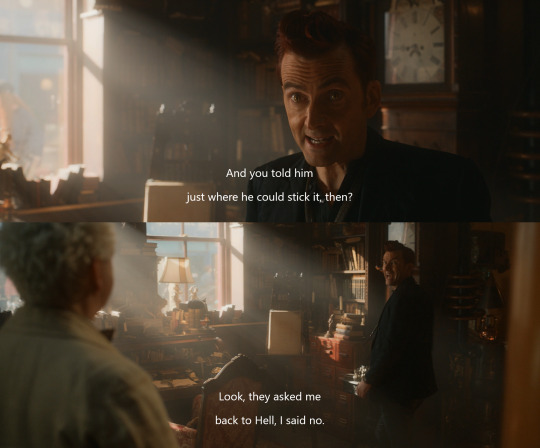
Crowley said he rejected Hell's offer, but did he? Let's compare the Beelzebub's and Metatron's methods. Let's find the parallels between the scenes.
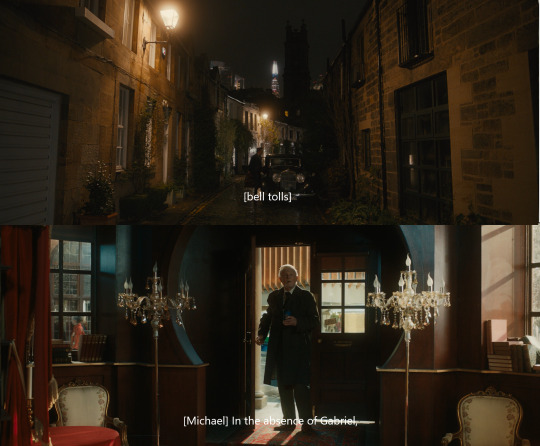
The appearance of the superiors is accompanied by bell ringing in both cases.
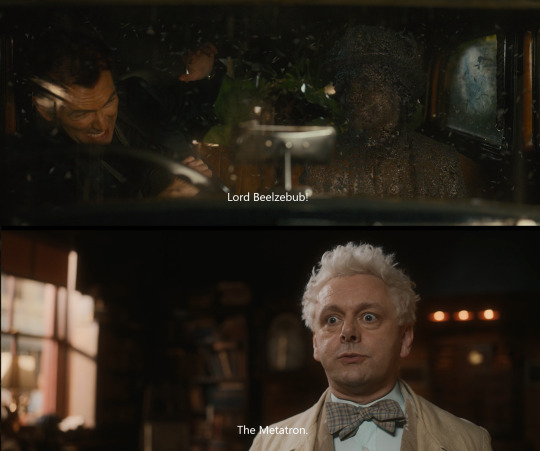
Crowley and Aziraphale are unpleasantly surprised, they exclaim their superiors' names. Why would such high-ranking bosses personally visit a traitors' hideout?
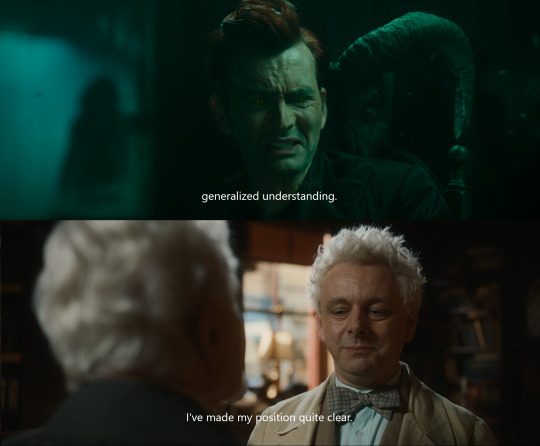
They remind about the arrangement with their superiors.
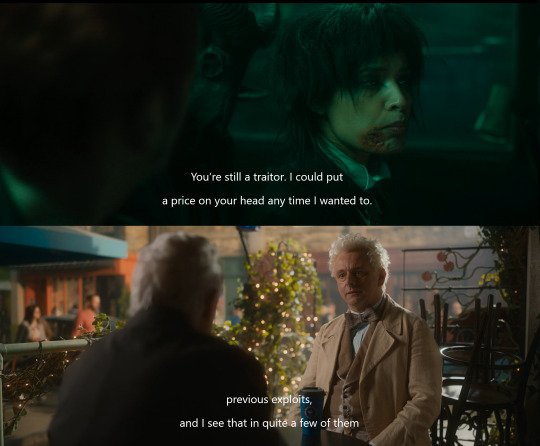
The threats: the direct one from Hell, the veiled one from Heaven.
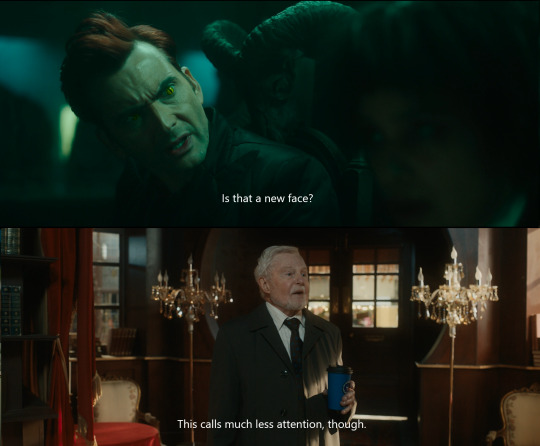
The change of guises.
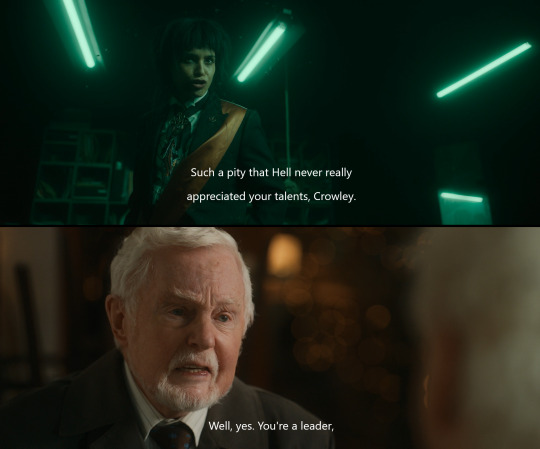
The flattery.
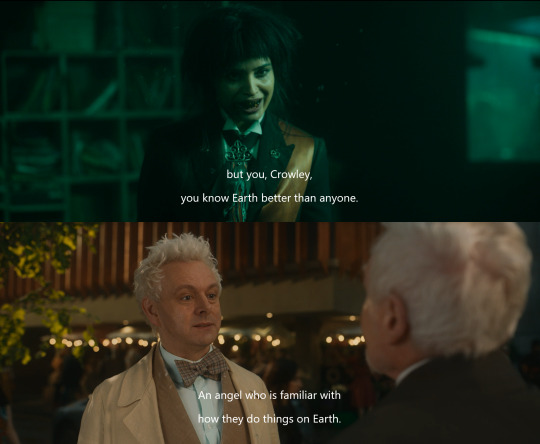
The knowledge of the Earth as the deciding factor for their choices.
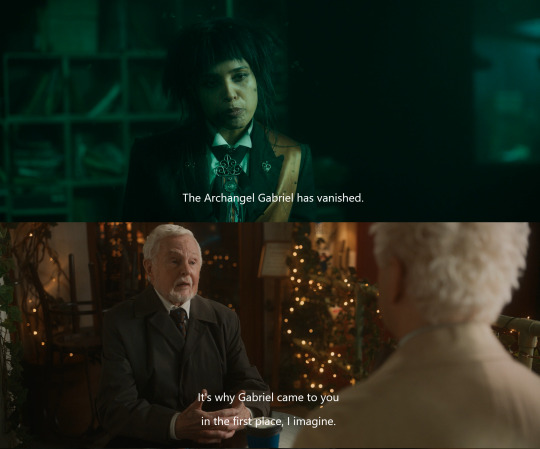
The mentions of Gabriel. It's logical for the conversation with Beelzebub, because the Prince's of Hell motives are already clear. Crowley was summoned for the purpose of finding their beloved Archangel.
What is the reason the Metatron mentions him? And as a benchmark for assessing Aziraphale's actions. From the point of view of the Voice's of God manipulative art, one can understand why. Aziraphale cannot be evaluated on the Michael or Uriel scale, because he himself considers them as bad angels.

And finally, the position offers. Crowley nodds while looking at Beelzebub, Aziraphale says he don't want to go to Heaven.
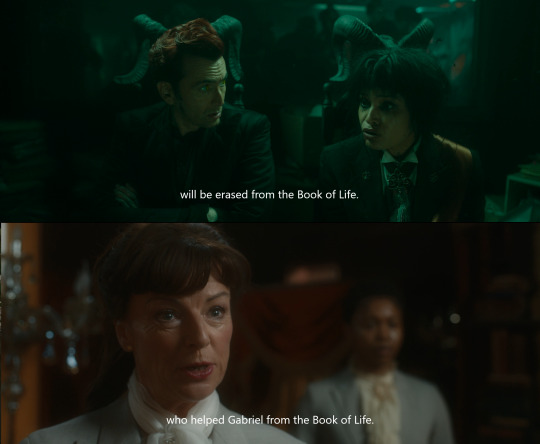
Bonus: the threats of erasing from the Book of Life. Crowley rushes to Aziraphale intending to save him. And Aziraphale having received additional threats from the Metatron tries to reproduce their conversation for Crowley.
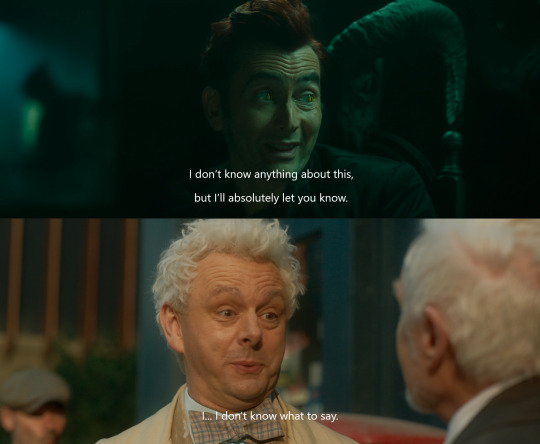
They're the same, Your Honour!
Crowley has refused to be a Duke of Hell just like Aziraphale has agreed to be a Supreme Archangel. Neither of them have responded yes or no.
It's clear this demon lied to Beelzebub, but his angel is also very experienced in this matter. And Aziraphale is accused of doing exactly as Crowley did. Without a chance to get out of it, he decided to keep silent, so as not to incur the wrath of his superior. Namely the Metatron who is even higher in rank than Beelzebub.
#crowley#aziraphale#good omens#good omens meta#good omens analysis#aziraphale x crowley#good omens 2
1K notes
·
View notes
Text
opened etsy and this is the first thing they showed me. i have so many questions and one of them is how many of these does michael sheen have in his possession

785 notes
·
View notes
Text
I'd seen comments about Crowley's anachronistic Roman clothing but had not seen a full breakdown of why it was unusual - this is awesome!
Crowley’s Roman Look is Very Strange

I didn’t. I didn’t want to be this person. But Aziraphale is sitting RIGHT THERE looking like A TOTALLY RESPECTABLE Roman citizen circa 40 AD. Maybe the hair might be unusual, but the Romans LOVED blonde hair. They thought it was cool and foreign and exotic in sort of a sexy way.
But Crowley is so historically confused. And I think the production design is too good and Neil Gaiman is too on top of his game for this to be accidental. It must mean something.
I - HAIR

What is on your head Crowley. Are you the emperor? Are you a victorious general currently participating in a victory parade?
Sure, you sometimes see laurel wreathes in portraits. But FUNERAL portraits.
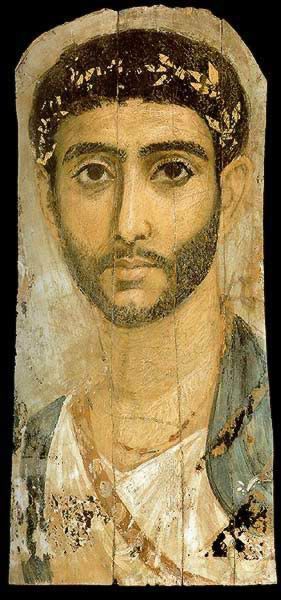
That crown is a symbolic thing, to celebrate your victories in life. It’s not STREET WEAR.
And okay. It’s 40-41 AD. Caligula is emperor. Military chic is in. If you’re a guy, you’re wearing your hair short and un-styled (LIKE AZIRAPHALE.) Those dramatic little spit curls wouldn’t show up until at least Nero.

But actually, pulling back for a second - are you appreciating the absurdity that is this hairstyle? Because it took me a second to notice that only the FRONT HALF is curled.
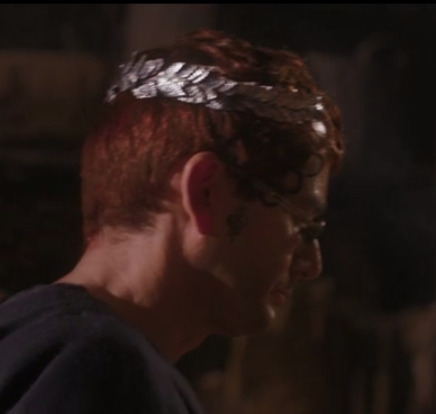
Which is a Roman hairstyle. But it’s a Roman LADY hairstyle.
(It tends to get called ‘Flavian Hair’ because the Flavian era ladies of the 70s-90s got pretty extreme about it, but you still had less… dramatic versions in the 40s.)
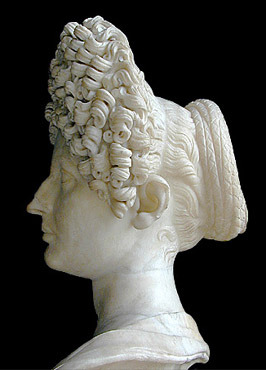
That’s you, Crowley. That’s your style reference. Honestly, if you had just kept your hair long everybody would have thought you were a cool barbarian chieftain or something.
II - CLOTHES
The black is fine. It’s eccentric, but fine. Romans wore black. Wearing black was Cato the Younger’s *thing.* It gets associated with mourning and/or protest, but it would have been really visually confusing to have Crowley wear some other color. This gets a pass.
Nope, my question is about his articles of clothing. There’s a charcoal grey garment that seems to be a toga + undershirt. It’s looped over Crowley’s arm, which is a classic toga give away.
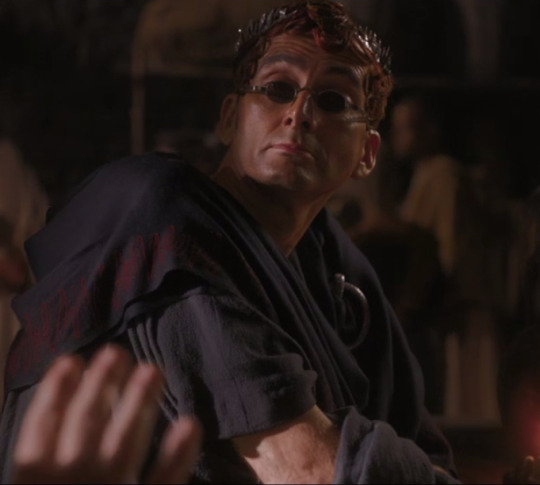
That part’s fine. But over the top, he’s wearing a true black… short cape? Shawl? it’s really hard to tell, because whatever it is, he is NOT wearing it correctly (is it folded in half?) Also, that irregular red zigzag pattern is very strange and I do not recognize it from anywhere. Seriously, I can’t even decide on a continent for this garment.
III - JEWELRY
Emperor Nero usually gets credit for inventing the first sunglasses, after he started watching gladiators fight though a green gemstone. He won’t be emperor for about ten years. But hey, he probably got the idea from somewhere. And dark glasses are just a really sensible way to hide your snakey eyes. This is also the first time we see Crowley put up some proper emotional barriers, so it’s a good place for the glasses to be introduced. (@theladyzephyr has a wonderful meta that goes into a lot more detail here.)
So the sunglasses are good. BUT THAT BROOCH.
Okay. This is Aziraphale wearing a fibula plate brooch

It’s a really Roman style, and a really Roman shape (a “pelta”)

I’ve never seen one that looks like angel wings, but a Roman citizen is going to look at that and see a soppily patriotic Imperial Eagle. How nice that this lovely man from Germania/Greece has made some money and become such an exemplary citizen!
But Crowley is wearing a penannular (pin-and-ring) brooch
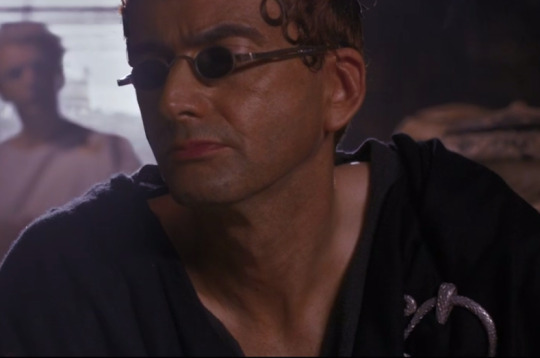
That’s not roman. That’s a style from the British Isles (Irish, Pictish, Scottish, Welsh.) It says barbarian, boonies, outskirts of the civilized world.
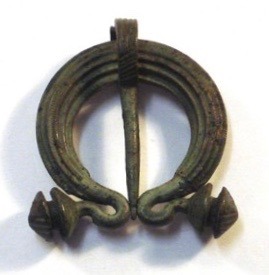
And nobody @ me with pictures of pin-and-ring brooches from Rome. Those are small, cheap, and undecorated. They’re the cultural equivalent of safety pins. This is patterned like a snake, and it’s the size of Crowley’s palm.

AND THAT’S ANOTHER THING. They didn’t do snake-themed jewelry in the British isles. Snakes didn’t have the best cultural associations there, and there weren’t too many of them there to begin with. This isn’t something Crowley picked up because “hey, a snake, cool,” and then got attached too. This must have been commissioned special.
But you know who LOVED snake jewelry?
ROMANS.

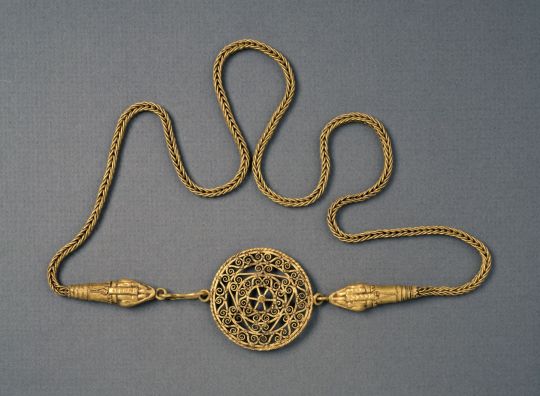
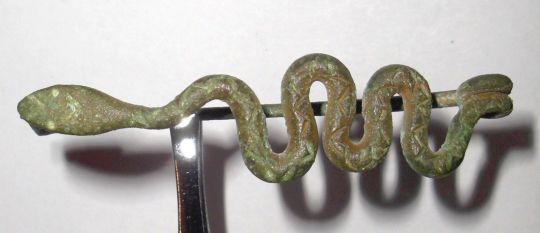
Romans associated snakes with healing and rebirth - clinics sometimes had lil snakes crawling around on the ground to give the place good vibes.
You cannot tell me that Crowley could have existed in Rome for any length of time and not picked up some of this jewelry. Which leads me to my conclusion:
IV - CROWLEY IS EXTREMELY NEW IN TOWN
The unfashionable pin and hair? The clothing draped the wrong way? The cultural colorblindness of wearing a laurel crown when you’re not supposed to? Crowley looks like a tacky tourist because he is one. He’s not staying here long, he “just nipped in for a quick temptation.”
He’s in a bad mod because he’s had an awful day, everyone keeps looking at him funny, the temptation was a complete bust, he has culture shock, and now he’s just trying to get a drink. But they don’t have any PROPER drinks like ALE or MEAD here, so he just orders “whatever’s drinkable.” He’s even not sure what they drink in Rome.
But then Aziraphale shows up and invites him to lunch some place fashionable. So everything’s going to be okay.
50K notes
·
View notes
Text
Very fun and interesting comparative analysis!
How act two of The Sound of Music might foreshadow Good Omens season three ~
I was reading this post about Aziraphale’s ball idea coming from The Sound of Music rather than Jane Austen, and remembered that I’d meant to make a post about parallels between Aziraphale and Maria. The romantic plot of Good Omens has a lot in common with the plot of The Sound of Music, and season two just so happens to leave off at the very end of act one. So, is there a chance that act two could provide some clues about season three? I find the idea very compelling, so here’s my analysis of the movie and how I think it compares to what we’ve seen so far, as well as what we can hope to see in season three.
In the beginning we have Maria at the abbey, where it is made clear that she does not fit in because she has a hard time abiding by the rules. She also has a tendency to prioritize the natural/material world over her spiritual duties, which is represented by the opening song (“The Sound of Music”), the singing of which literally makes her late to return to the abbey. This has obvious parallels to Aziraphale’s difficulties conforming to Heaven’s way of life, as well as his worldly attachments.
(A fun bonus parallel is in the song “Maria,” when the nuns say “she’s always late for everything / except for every meal.” Aziraphale-coded fr.)
Maria leaves the abbey to be the governess to the von Trapp family, and this is where she begins to really learn about herself as an adult outside of a tightly controlled religious environment. She still doesn’t conform to the new world she lives in, but begins learning how to retain her selfhood without feeling ashamed of doing so. This period is obviously a parallel for Aziraphale’s time on Earth—although the time frames are quite different, the same general lessons are learned.
At the end of act one, as addressed in the linked post, there is a ball where the Captain and Maria dance, and this is the moment where Maria discovers her feelings for the Captain. Although this scene is an obvious parallel for the Jane Austen ball scene, I think it’s honestly more similar to the kiss in the final 15. Maria, mid-dance, stares into the Captain’s eyes, freezes, and backs away, saying she can’t remember the dance anymore. The Baroness is watching from the doorway, and when Maria runs upstairs to get changed for dinner, the Baroness follows her.
Up in Maria’s bedroom, the Baroness confronts Maria about her feelings for the Captain, which Maria denies initially. The Baroness convinces her of her own feelings and of the Captain’s, and essentially encourages her to run away—I’ll get into why in a second. Without a word to anyone, Maria returns to the abbey. This is a super obvious parallel to the end of season two, with the Baroness acting almost in the role of the Metatron by pulling Maria aside and reminding her of her “duty.”
Now into the more speculative side of things, trying to think of how The Sound of Music might offer hints as to what’s coming in season three.
When Maria returns to the abbey, she remains in constant silent prayer for the first several days before being called upon by the Abbess. Maria confesses that she ran away because she was frightened, and admits that she had accidentally developed an attraction for the Captain. She gives her reason for not telling the Captain about her feelings and choosing to return the abbey: “I was there on God’s errand. Oh, I couldn’t stay, I just couldn’t. I’m ready at this moment to take my vows.” This sense of misplaced duty might not be all of it, but again, we’ll get to that in a second.
The Abbess responds with probably more kindness than we’d expect from anyone in Heaven: she says that romantic love can be holy, that Maria needs to discover how God intended her to spend her love, and assures her that “if you love this man, it doesn’t mean you love God less.” With this, she commands Maria to return.
While this may seem incongruous with Heaven’s general business model and something unlikely to be paralleled in season three, I think it’s important to think back to the conversation at the end of season one immediately following the failed apocalypse, when Crowley asks, “Angel, what if the Almighty planned it like this, all along? From the very beginning?” People joke about God trying to set them up from the beginning of time, but I don’t know that it necessarily has to be a joke. The question of God’s ineffable plan is a constant throughout the series—the whole point is that it’s impossible to say what exactly God intends.
This is the exact same conflict Maria faces in the scene with the Abbess. When she objects to returning, she says, “But I pledged my life to God, I — I’ve pledged my life to his service.” The Abbess rejects the idea that this is the only possible plan that could have been intended for Maria, saying, “You have to live the life you were born to live.” Perhaps there will be something similar in season three, some way in which God communicates the same thing to Aziraphale—that loving Crowley doesn’t mean loving Her any less, that their love is holy, and that the life he is meant to live is not one pent up behind heavenly walls, but rather out in the world with Crowley.
After Maria returns, she’s reunited with the children, the Captain and the Baroness break off their engagement, lots of little plot things. What I’m interested in is the song “Something Good” (which I would just like to emphasize is sung in a gazebo... anyway). The song introduces an additional reason for Maria’s departure—namely, that she did not feel worthy of the Captain’s love, a sentiment that he returns. They both come to the conclusion, though, that they must have done “something good” to deserve having found each other. Here are some lyrics:
For here you are, standing there, loving me
Whether or not you should
So somewhere in my youth or childhood
I must have done something good.
The basic theme of the song is self forgiveness, and the acknowledgement that past imperfections do not make a person unworthy of being loved. Rather, both characters here have felt themselves to be inadequate, but view the other’s love as a sign that they must, in some way, be good.
I love the idea that Crowley and Aziraphale might have a moment like this, because I think it would be massive in terms of their own self acceptance. For Crowley, Aziraphale’s love (and possibly God’s endorsement?) is proof that his fall did not make him irredeemable, that he remains a being who can love and be loved in return. For Aziraphale, Crowley’s love is an affirmation that he can honestly be forgiven for his transgressions, rather than marked forever by them (like removing the stain from his coat, allowing it to be forgotten).
Unfortunately, the movie does not end with their marriage—they still have to escape Austria after the Captain is called to serve by the Nazis. I think we can assume the Nazis parallel Hell, and say that perhaps Aziraphale and Crowley really will have to establish “their own side.” Maria has to break free of the abbey, and the Captain has to break free of the Nazis. They do this by running away, and I’m not sure Aziraphale and Crowley would ever flee Earth in the wake of the Second Coming, but I will say that it does immediately evoke the idea of the pair running away to Alpha Centauri. I do think that given the “they are bad at their jobs and did very little to seriously prevent Armageddon” joke from season one, it would be a little funny if humanity managed to save itself during a momentary retreat from Aziraphale and Crowley.
I don’t mean to imply that the blueprint of season three is found in act two of The Sound of Music, but I do think that the movie being canonically a favorite of Heaven’s, the recurring theme of the ineffability of God’s plan, and the sheer number of parallels within the plot so far make it a fair place to look for clues. Who’s to say that God’s plan wasn’t hidden in plain sight?
75 notes
·
View notes
